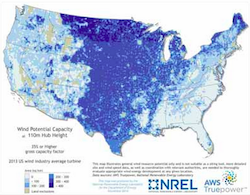The U.S. Department of Energy (DOE) has allocated $2.5 million to help improve wind forecasting. Louisville, Colorado-based Vaisala will research the atmospheric processes that generate wind in mountain valley regions and the data will be used to improve wind weather models for short-term wind forecasts. Better forecasts will allow energy plant operators to operate wind turbines closer to maximum capacity.
 The industry has found that mountain-valley areas bring additional challenges including varying degress of soil moisture and surface temperatures making it more difficult to forecast wind energy output. Vaisala and its partners will use advanced meteorological equipment to analyze specific environmental characteristics that affect wind flow patterns in the Columbia River Gorge region of Washington and Oregon.
The industry has found that mountain-valley areas bring additional challenges including varying degress of soil moisture and surface temperatures making it more difficult to forecast wind energy output. Vaisala and its partners will use advanced meteorological equipment to analyze specific environmental characteristics that affect wind flow patterns in the Columbia River Gorge region of Washington and Oregon.
Data collected during the project will be shared in near real-time with the National Oceanic and Atmospheric Administration (NOAA) and the Energy Department’s national laboratories, and will be used to develop improved atmospheric simulations for the Weather Research and Forecasting model, a widely used weather prediction system. These new wind measurements and simulations will also be incorporated into NOAA’s Numerical Weather Prediction models to improve short-term wind forecasts in complex terrain.
This important research builds on the Energy Department’s Wind Forecast Improvement Project, which previously explored wind energy resources in the northern Great Plains and western Texas. For the first time ever, NOAA assimilated wind data from tall turbines and nacelle anemometers into meteorological models for use by the wind industry and other sectors. Integrating these new data into existing models produced forecasts that were up to 15% more accurate at predicting future wind conditions in nearly flat terrain.

